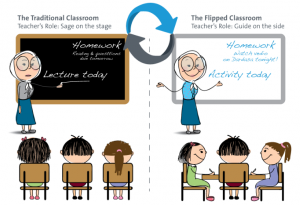
When I began looking through Salman Khan’s titles in The One World Schoolhouse, I was instantly hooked on “Flipping the Classroom.” As I read, I felt validated with how my teaching style has changed over the past year as I began incorporating more flipped lessons in the first grade classroom. I agree with Salman Khan that the students need to learn from my direct instruction during the school day, but they also need active opportunities to learn by synergizing with other learners who are at different ability levels and having a support system in place to help with challenges along the way. Working with other learners and having a support system is something that not all students will not have access to when they are tackling school work at home. Students and families are often left frustrated because they do not have a support system to help understand the problem. Although the homework in first grade is not like homework in the upper grades, flipped classrooms or flipped lessons create a “Win-Win” for everyone involved.
As I reflect on my high school experience, I feel like flipped lessons would have helped me tremendously as a learner. I was the student in math struggling to keep up. I was often stopping the teachers to ask questions along the way. When it came time to do the homework, I was still trying to process the lesson that was just presented to me. I would often go to the teacher for help before the start of the school day. I felt like I was doing whatever I could just to keep my head above water. By the time I understood the skill, we were on to the next topic. If I had the opportunities to practice with teacher and collaborative student support, I feel like I would have more success grasping the concepts.
Incorporating YouTube lessons or other videos is quite simple with the Seesaw app. All you need to do is create your video and upload the link. You can share your video by clicking on specific students or the entire class. The nice thing about Seesaw is that the students can click on the three dots on your post, click copy and edit, and respond to the video by recording their voice or typing in a response. What a great way to capture the learning! If you need help designing a flipped lesson for your students on Seesaw, let me know!

Great idea about using See Saw, Kellie! I will be coming back to this post for a refresher.
I completely agree that flipped lessons would have helped me as a student. Often, in math I was too intimidated to ask a question. But being able to watch something on my time AND go back and rewatch it would have helped. I think then a student has real questions to ask in class of the teacher instead of just, “I don’t get it.” (Which is how I felt in math A LOT as a student!!)
Kellie,
I am flipping for this post. HAHA.
I love the idea of the flipped classroom. I think that students working through problems and lessons while the teacher is there to support is invaluable. I remember my own experience with homework. When I would get home what seemed to make sense in class all of a sudden didn’t anymore and I wish I could have turned to the teacher for discussion and help. Why not get the lecture part of the concept at home or on your own time and really utilize class time to go deeper with the professional educator available. Kirk Humphreys at Caruso is a master of the flipped classroom. It is more complicated than it sounds and what kids are viewing or watching without the teacher has to be extremely clear and engaging as well. You can’t just pull a random video of how to add fractions – it should be a video with the classroom teacher for the most part I think.